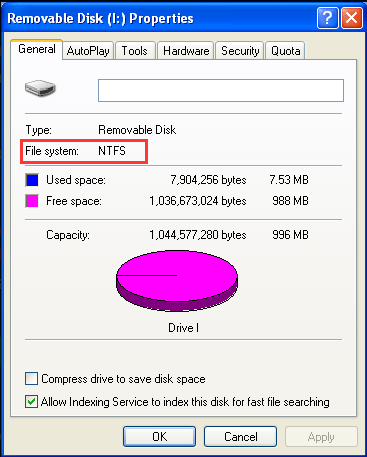NTFS is the modern file system used by Windows by default. NTFS's file size and partition size limits are theoretically huge. NTFS first appeared in the consumer version of Windows XP, although it was originally introduced on Windows NT.
NTFS is short for the New Technology File System and is a proprietary file system developed by Microsoft. Starting with Windows NT 3.1, it is the default file system for the Windows NT family. It was first introduced by Microsoft in 1993.

Before the advent of NTFS, the default file system of Windows operating systems is FAT32 file system. However, FAT32 has its limitations, for example, the single file size of it cannot be bigger than 4GB and partition with a maximum size of 32GB. In addition, it does not provide any data protection when power off.
While as a successor, NTFS can deal with all these problems and more: NTFS offers a number of improvements over FAT such as supporting metadata and using advanced data structures to improve performance, reliability, and disk space utilization, and several additional extensions.
The Superior Features of NTFS
Compared to the Windows 95 file allocation table (FAT), you can’t deny that NTFS does so great job in performance, extendibility, and security.
- Safer file protection, file encryption, and greatly improved information security.
- Support large hard disks over 2TB, and as disk capacity increases, NTFS performance does not decrease as FAT does.
- Set permissions for individual users. Different users can be assigned different permissions for the same file or folder.
- The resiliency designed in the NTFS file system does not require the user to run a disk fix in the NTFS volume. If you encounter a system crash, the NTFS file system automatically restores file system consistency using log files and reviews point information.
- The B-Tree structure of the NTFS folder allows users to access files in larger folders faster than files in smaller folders in the access volume.
- Individual files and folders can be compressed in NTFS volumes. The compression mechanism of the NTFS system allows users to directly read and write compressed files without the need to use decompression software to expand these files.
- File and directory names can be up to 255 characters long, including any extensions. Names preserve case, but are not case sensitive. Names can contain any characters except for the following: ? ” / \ < > * | :
- Support for disk quotas. Disk quotas manage and control the maximum disk space that each user can use.
NTFS’s improvement of FAT32 must be described as “excellent”. NTFS not only supports security file permissions to help you quickly recover bad change logs, encryption, disk quota limits, etc., but also hard links, backup shadow copies, and various other features. Many of them are critical to operating system drives – especially file permissions.
The Weak Points of NTFS
In fact, the biggest disadvantage of the NTFS file system is its compatibility.
- Many removable devices such as Android smart phones, do not support NTFS.
- NTFS formatted drives can be written to only with the help of third-party software in Mac OS computers.
- Some media devices such as DVD players and digital cameras, do not offer support for NTFS storage devices.
- It does not include a system that guarantee file system performance and bandwidth like other newer file systems do.
- The NTFS file system can only be compatible with Windows 2000 and later versions of Windows. Windows 95/98/ME and MS-DOS are not compatible with NTFS.
Why Choose NTFS over FAT?
Except what we mentioned above, simply put two points here: NTFS improves space utilization and can be resized.
For resizing, starting with Windows Vista, Microsoft has added built-in features for shrinking or extending partitions. It is only can be used for NTFS or RAW. For how to resize a FAT partition, Windows cannot help you while the professional partition manager – MiniTool Partition Wizard can do this job.
For the space utilization, a cluster is only allowed to put one file, while a file can take more than one cluster. So, if the cluster is small enough, the partition can save more wasted space. NTFS supports more sizes of cluster than FAT32. This means its cluster can be smaller, making more efficient use of the partition.
According to the advantages of NTFS, many of you may prefer NTFS to FAT. Read Convert FAT to NTFS to get the skill.